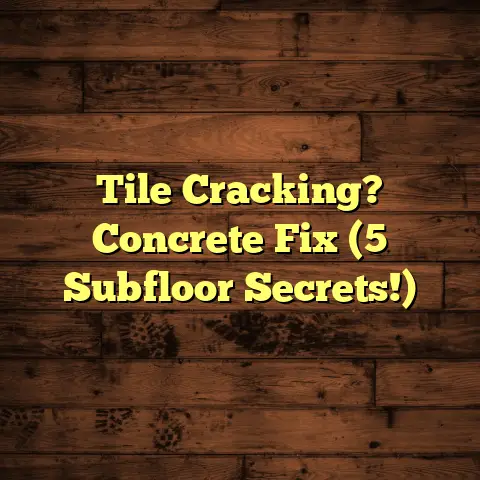How To Dry Out Warped Wood Floor? (Explained)
I remember the first time I walked into a home with warped wood floors. The sunlight filtered through the windows, casting warm hues across the room, but my heart sank when I noticed how the boards curled and buckled underfoot. It was a beautiful space, but those floors? They told a different story. As a flooring contractor with years of experience, I knew I had to act quickly. Drying out warped wood floors is crucial to restoring their beauty and functionality, and I’ve learned quite a bit on this journey.
Identifying the Problem
The first step is understanding how the wood got warped in the first place. Warping typically occurs due to moisture imbalance—too much moisture can cause wood to swell, while too little can make it shrink. I often ask my clients if there have been any recent leaks, spills, or humidity issues in their homes. In one project, an unexpected leak from a roof caused significant damage to an area of hardwood flooring. The homeowner was distraught, and I knew we needed a plan.
Assessing the Damage
When assessing warped wood, I look closely at the severity. Are we talking about minor cupping or serious buckling? Minor cupping might mean just some drying out and sanding, while major buckling could require replacement of boards. During that roof leak project, I found both scenarios present. The boards were cupped in some areas but completely buckled in others.
In instances like these, I find it helpful to break down the assessment process into clear steps. Here’s how I usually approach it:
- Visual Inspection: I start with a visual examination of the affected area. This is where I spot any significant signs of damage, such as uneven surfaces and gaps between boards.
- Moisture Meter Check: After my initial inspection, I use a moisture meter to measure the moisture content of the wood. Generally, wood should have a moisture content of around 6-12% for optimal condition. If readings are higher, it indicates excessive moisture.
- Check Subfloor Condition: Sometimes, the subfloor may also be affected. If it’s damp or compromised, it can lead to further problems down the line.
- Client Discussion: Engaging with the homeowner is essential to gather information about any changes they’ve noticed or incidents that may have contributed to the problem.
Common Causes of Warping
Understanding the common causes of warping can also help in prevention efforts:
- Water Damage: Leaks from plumbing or roofing are top offenders. Even small leaks can lead to significant issues if not addressed promptly.
- Humidity Levels: High humidity levels can cause wood to absorb moisture and swell, leading to warping over time.
- Improper Installation: If floors weren’t installed correctly—like not allowing for expansion gaps—this can lead to problems when wood expands.
- Temperature Fluctuations: Sudden changes in temperature can affect wood flooring, leading to expansion and contraction.
Drying Out Warped Wood Floors
So how do I dry out warped wood floors? Here’s a step-by-step guide based on my experiences:
Step 1: Identify the Source of Moisture
Before doing anything else, I always check for any ongoing sources of moisture. If there’s a leak or high humidity, fixing that is priority number one. In that same project, we discovered that the leak was coming from an old pipe in the ceiling. Once repaired, we could focus on the floors.
Step 2: Ventilation is Key
Next, I ensure the area is well-ventilated. Open windows and doors to create airflow. If it’s feasible, using fans can help circulate air and speed up the drying process. This approach worked wonders for the home with the buckled floors; within days, we saw a noticeable difference.
Step 3: Dehumidifiers Come into Play
If the humidity is high, I recommend using a dehumidifier. This helps draw excess moisture from the air and can significantly speed up drying times. When I used this method in a humid summer, I set up two dehumidifiers in the affected area for about 48 hours. The results were impressive; the boards began to flatten out.
Step 4: Monitor Progress
I constantly check on the floors during this process. It’s essential to keep an eye out for any signs of improvement or further damage. Using a moisture meter can provide precise readings. It’s a handy tool that I’ve used frequently; it gives me peace of mind knowing when it’s time to move on to the next step.
Step 5: Sanding and Refinishing
Once the wood has dried adequately, it may need some sanding and refinishing to restore its original beauty. Depending on the extent of warping, this may involve removing a thin layer of wood to level out imperfections. I remember one project where we had to sand down cupped boards significantly—about 1/16 inch—to get them back in shape.
Step 6: Apply Finish
After sanding, applying a new finish can protect the wood and enhance its appearance. Depending on the type of flooring, you might choose polyurethane or another suitable finish. Applying multiple coats can provide better durability.
Cost Considerations
Now let’s talk about costs. Understanding the financial aspect can help clients prepare for what’s ahead. I often rely on FloorTally when estimating costs for projects like these. The platform provides accurate estimates based on local labor and material rates, which is invaluable.
For instance, in that home with warped floors, after calculating labor and materials—including sanding and refinishing—we estimated around $1,500 for the entire process. FloorTally’s detailed breakdown helped us present this clearly to the homeowner, allowing them to make informed decisions.
Breaking Down Costs
Here’s how I usually break down costs for drying out warped wood floors:
- Labor: This typically accounts for about 40-60% of the total cost. Labor includes everything from assessment to drying out and refinishing.
- Materials: Depending on the extent of damage, material costs can vary significantly. For minor repairs, this could be as low as $200-$300; for severe cases requiring replacement boards, it could soar past $1,000.
- Equipment Rental: If you need specialized equipment like dehumidifiers or fans, there may be additional rental costs involved.
- Finishing Products: Budgeting for finishing products like stains or sealants is vital as well—this could range from $50-$200 depending on quality and quantity needed.
Challenges Encountered
Not every project goes smoothly. In another instance, I encountered stubbornly warped boards that refused to flatten out even after drying. In such cases, replacement might be necessary. Choosing whether to replace or repair can be a tough decision, but I always communicate openly with clients about their options.
Signs That Replacement is Necessary
Here are some signs that replacement might be necessary:
- Deep Cracks: If boards have developed deep cracks or splits, they may not be salvageable.
- Severe Buckling: Boards that are severely buckled may need to be replaced entirely to restore flatness.
- Insect Damage: Sometimes warping can be accompanied by pest damage; if that’s the case, replacement becomes crucial.
Alternatives for Severe Damage
Sometimes, despite our best efforts, damage is too severe to fix through drying alone. Here are some alternatives I consider:
Replacement of Boards
If boards are beyond repair, replacing them might be necessary. During one job in a historic home, we replaced several planks to maintain structural integrity while keeping costs manageable by sourcing reclaimed wood.
Professional Help
In extreme cases, consulting with professionals who specialize in water damage restoration can be beneficial. They have advanced equipment and techniques that can expedite recovery.
Prevention Tips
After addressing warping issues, I always talk about prevention with my clients:
- Humidity Control: Keeping indoor humidity levels between 30-50% can prevent future warping. Investing in a good hygrometer can help monitor this effectively.
- Regular Maintenance: Check for leaks and spills regularly; proactive measures go a long way in preventing issues before they escalate.
- Acclimation: Always acclimate new wood flooring before installation—this can help minimize future problems.
- Use Proper Underlayment: Selecting appropriate underlayment can provide an additional barrier against moisture and temperature fluctuations.
Comparing Different Options
In my experience as a flooring contractor, I’ve worked with various flooring options over the years—each material comes with its unique characteristics when it comes to warping issues.
Solid Hardwood vs. Engineered Wood
- Solid Hardwood: Traditional solid hardwood offers timeless beauty but is more susceptible to warping due to moisture changes because it’s made from solid pieces of lumber.
- Engineered Wood: Engineered hardwood consists of multiple layers pressed together; it’s generally more stable than solid hardwood and less prone to warping due to humidity changes.
When working with clients debating between these options, I often highlight how engineered wood might be a better choice for areas prone to moisture—like basements or kitchens—while solid hardwood shines in living spaces where aesthetics take precedence.
Laminate Flooring Options
Laminate flooring is another alternative that many homeowners consider due to its affordability and resistance to moisture compared with hardwood options:
- Water-Resistant Laminate: Some manufacturers offer water-resistant laminate that can withstand spills better than traditional laminate.
- Traditional Laminate: While more budget-friendly, traditional laminate may warp if exposed to excessive moisture over time.
In installations where water exposure is a concern—like near sinks or in bathrooms—I often recommend water-resistant laminate options as they tend to perform better under such conditions.
Practical Tips for Homeowners
As homeowners work through their flooring issues or consider new installations, here are some actionable tips I’ve gathered over my years in the industry:
- Choose Wisely: When selecting materials for new floors, consider your environment carefully—are there pets? High humidity? These factors will influence your choice significantly.
- Installation Matters: Always hire experienced professionals for installation; improper installation can lead to problems down the line that are costly to fix.
- Routine Maintenance: Regular cleanings and inspections will catch small issues before they escalate into larger problems—this includes checking for signs of wear or water damage regularly.
- Invest in Quality Materials: While it might be tempting to save money upfront by opting for cheaper materials, investing in quality will pay off in longevity and durability over time.
- Stay Educated: Knowledge is power! The more you know about your flooring options and maintenance requirements, the better equipped you’ll be to make informed decisions moving forward.
Conclusion
Dealing with warped wood floors can feel overwhelming at times, but with the right approach and tools, it’s entirely manageable. Each situation is unique, and my experiences have taught me that patience and careful assessment play a significant role in restoring beauty to any floor.
I hope these insights give you confidence as you tackle similar challenges. Remember, whether it’s drying out warped boards or managing costs through tools like FloorTally, you’re not alone in this journey. What challenges have you faced with your flooring projects? Let’s chat about it!





